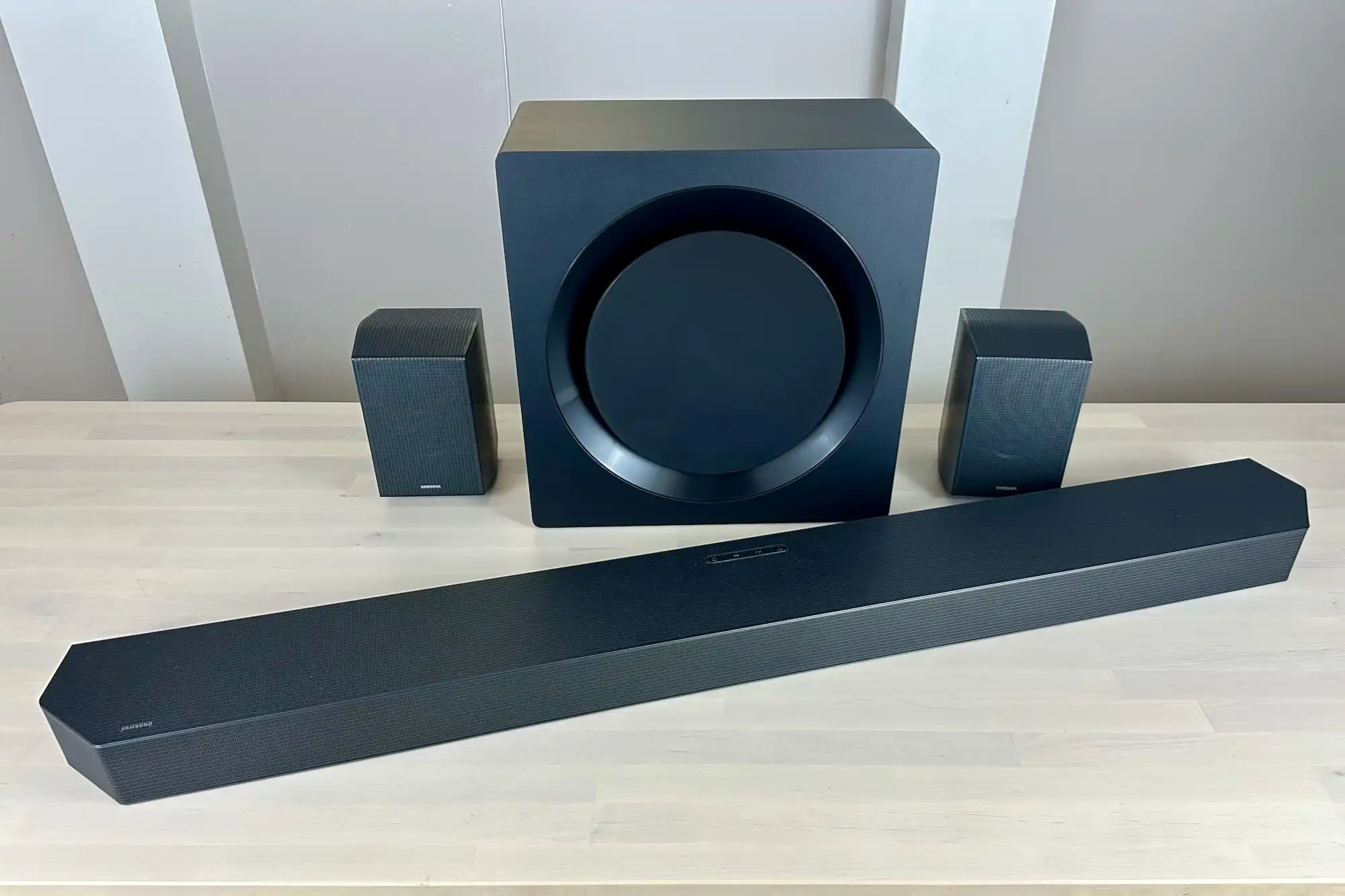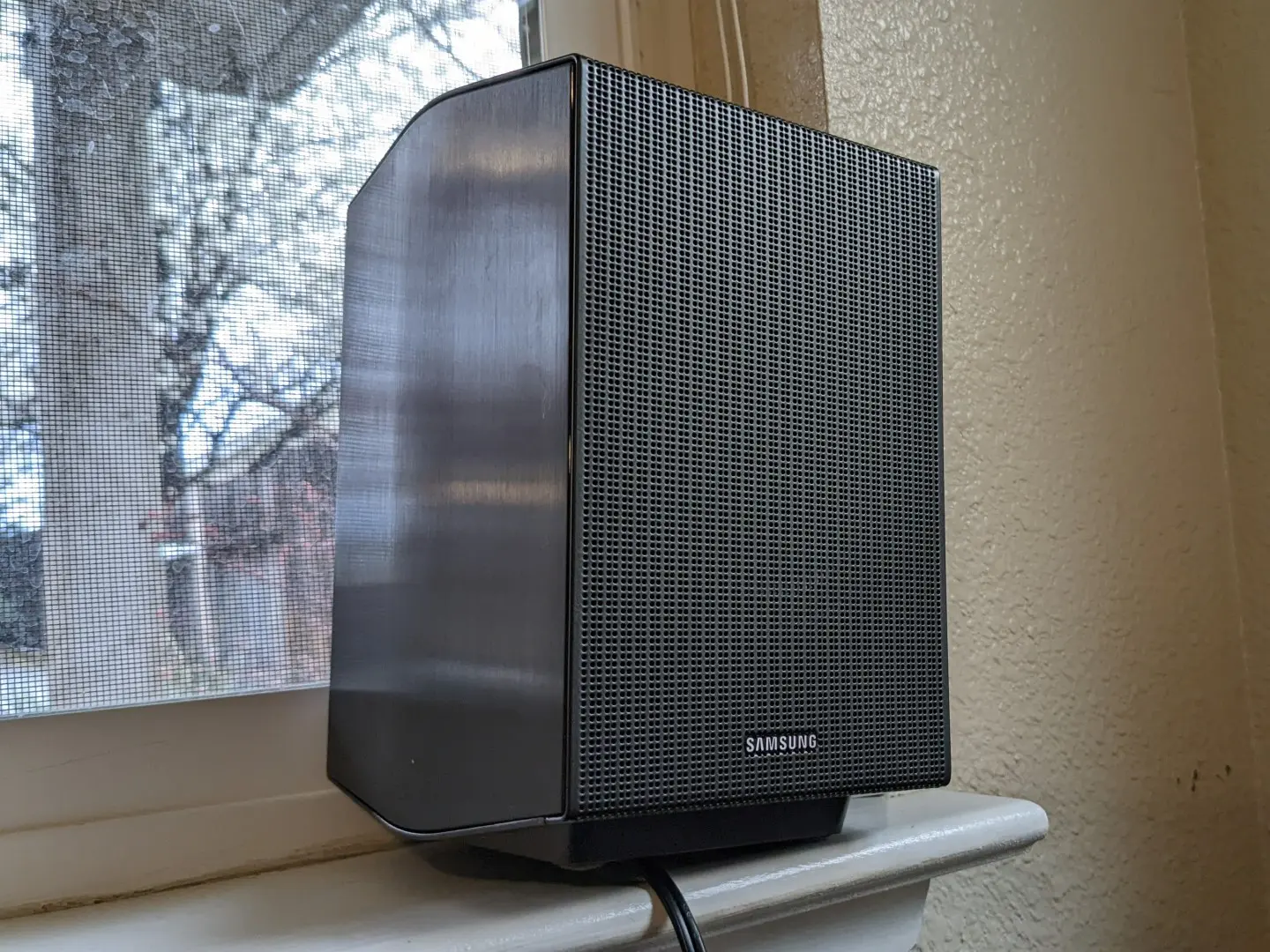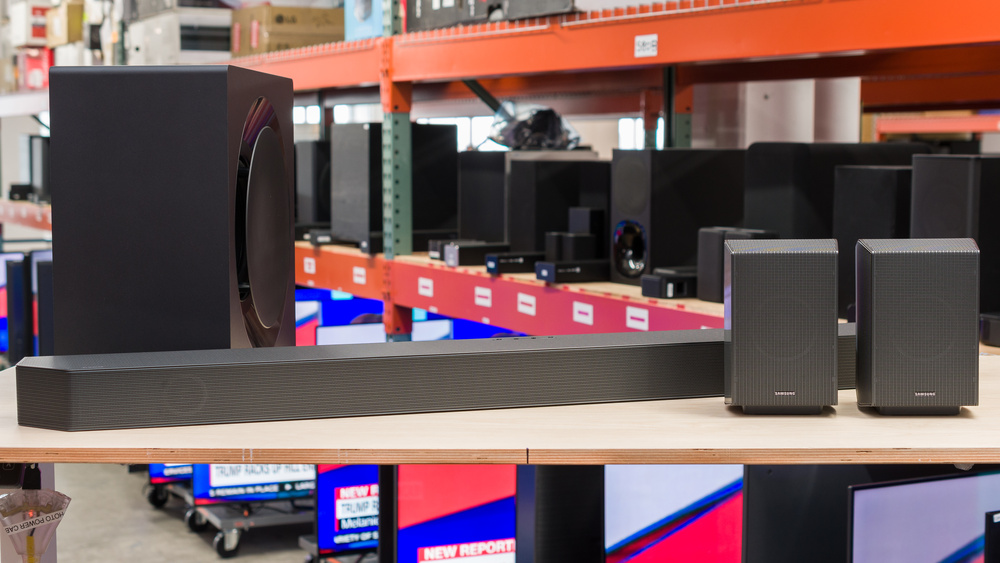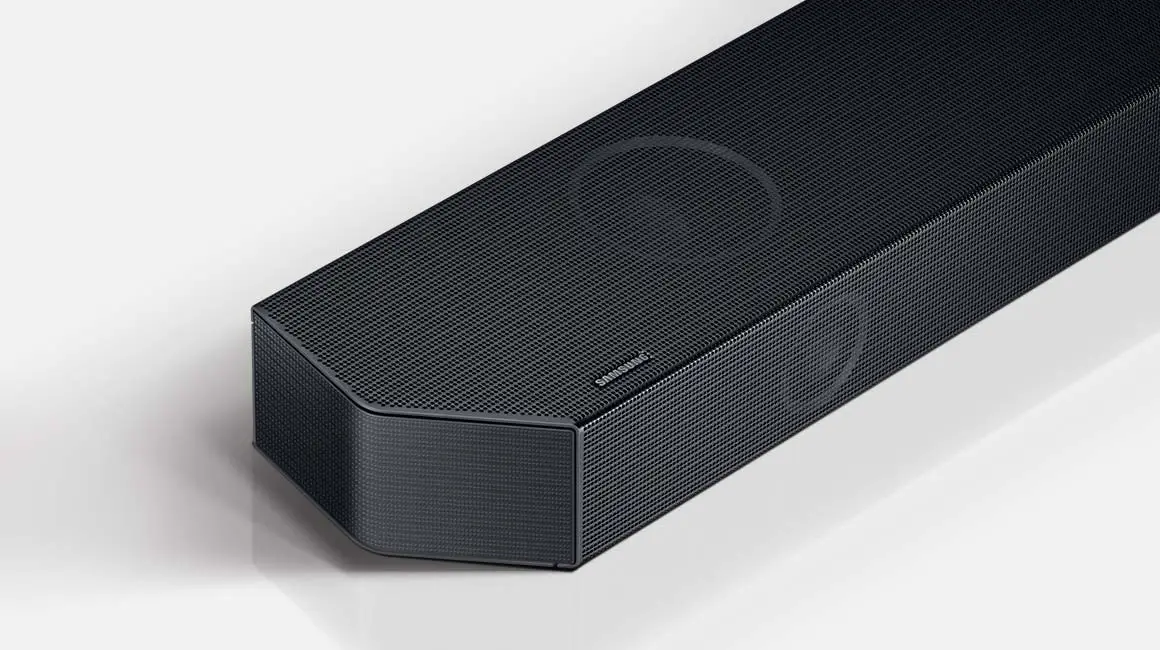When it comes to setting up a home theater, it’s common to purchase a soundbar, subwoofer, and rear speakers separately. While some companies may bundle a subwoofer with the soundbar, high-end models often require separate purchases for a complete and immersive sound experience. Samsung takes a different approach with the HW-Q990C soundbar ($1,900), including all necessary additional speakers in one package, albeit at a premium price. This comprehensive system offers Dolby Atmos, a variety of audio options, and two HDMI inputs, delivering crisp 11.1.4-channel sound that fills your living room. While the Q990C entails a significant investment, it provides a one-stop solution for your home theater needs.
Design
The Q990C stands out as Samsung’s premium soundbar in its current lineup, and it boasts an impressive size to accommodate its advanced features. With a width of 48.5 inches, it is slightly smaller than the Sony HT-A7000 by about three inches. This extra space is essential for flagship models to house a multitude of speakers. In the case of the Q990C, it incorporates 11 front-facing drivers (including some side-firing), four up-firing drivers, and an internal subwoofer. The separate wireless subwoofer is also substantial, measuring 16 x 16 x 8 inches and weighing 26 pounds. While the wireless rear speakers are not oversized, they feature a three-driver setup with front-, side-, and up-firing drivers, providing enhanced audio capabilities compared to some other offerings on the market.
Samsung chose a mesh plastic covering for both the soundbar and rear speakers, offering a practical advantage in terms of cleanliness compared to traditional speaker fabric. The design of the soundbar itself is kept simple, featuring only four buttons on the top surface. Among these, there is a multi-function button that either powers the speaker on or cycles through input sources, along with volume controls and a microphone mute button. Positioned on the front, a small display on the right side provides information on input sources, volume levels, and other settings. Notably, the side panels of the Q990C do not follow the traditional 90-degree angles; instead, they align with the position of the side-firing speakers.
Setup
Setting up the Q990C is remarkably straightforward, making it one of the easiest processes I’ve encountered for a home entertainment package. After powering on the soundbar and linking it to the SmartThings app, the subwoofer and rear speakers are automatically integrated upon activation. No waiting time is needed for synchronization, and there’s no requirement to connect each component individually. While the sub and rears do have buttons for manual connection to the soundbar, I found this unnecessary as the automatic setup was swift and hassle-free, allowing for a seamless transition to enjoying music and movies shortly after unboxing.
Much like other premium soundbars, Samsung has incorporated two extra HDMI inputs in addition to the HDMI eARC jack designed for TV connection. While many more budget-friendly and compact models rely solely on the eARC connection, higher-end models typically provide additional alternatives for direct soundbar connection. The Q990C is expected to support 4K/60 and HDR10+ passthrough, but it lacks HDMI 2.1, resulting in the absence of 4K/120—a significant omission for a $1,900 soundbar in 2023.
Furthermore, the Q990C features an optical input, Bluetooth, and Wi-Fi connectivity. The latter introduces Tidal Connect, Spotify Connect, and AirPlay, enabling wireless connection to a compatible Samsung TV for audio. This allows for Dolby Atmos delivery to the soundbar without any cables visible, particularly beneficial if your TV is wall-mounted. For users with a compatible Samsung phone, the Tap Sound feature enables Bluetooth connection to the Q990C through a gentle touch on the speaker, although this feature couldn’t be tested on an iPhone.
SmartThings app and other features

The SmartThings app not only aids in the setup process but also serves as the control hub for adjusting the Q990C’s settings. The device screen prominently displays the current input and volume controls, with sound modes, EQ, and woofer level located just below. Notable features include SpaceFit Sound, automatically tuning audio to the room, and Active Voice Amplifier, optimizing on-screen dialog to counteract room noise. The advanced settings menu offers voice and bass enhancement, along with a Night Mode, yet these options are limited to on or off toggles without further customization. Users can select either Bixby or Alexa as the preferred voice assistant through the SmartThings app.
The soundbar provides a choice of Standard, Surround, Game Pro, and Adaptive Sound modes. Standard maintains unaltered audio and is the only mode offering a fully adjustable EQ (limited to bass and treble in other modes). For Surround mode, the Q990C upscales 2.0, 5.1, and 7.1 audio to the 11.1.4-channel output. Game Pro optimizes sound for a more immersive gaming experience, while Adaptive Sound analyzes audio in real-time to ensure clear dialog at various volumes, making it suitable for movies, news, sports, and music.
The included remote features a dedicated button for cycling through sound modes and a Sound Control button for accessing SpaceFit Sound, Active Voice Amplifier, Voice Enhancement, and more. Additionally, the remote includes a Channel Level button for adjusting individual speaker volumes, covering Center level, Side level, Wide level, Front Top level, Rear level, Rear top level, and Rear side level. Tone Control is also accessible, providing quick adjustments to bass and treble. Standard functions such as power, input, volume (overall and subwoofer only), mute, pairing, and playback options are conveniently available, making it a comprehensive remote for soundbar operation.
Sound quality

Thanks to the Q990C’s exceptional upscaling capabilities, the audio experience is significantly enhanced, creating a more immersive feel for nearly every movie or TV show compared to stereo or even a 5.1 setup. Even with the more affordable monthly rate on Netflix’s Drive To Survive, which offers Dolby Atmos in the priciest Ultra HD plan, the soundbar impressively captures the whir of cars zooming past, pitlane ambiance, and impactful crashes, enhancing the overall viewing experience of the meticulously-shot series. Marvel shows and movies on Disney+, available in Atmos, also deliver amazing sound quality.
This soundbar provides a movie theater-like experience in the living room, especially due to the additional drivers in the rear speakers that significantly contribute to a heightened sense of overhead and directional audio compared to standard single-driver units. Fight scenes, like the opening of The Falcon and the Winter Soldier, are rendered with lifelike intensity, capturing the thud of each punch, the fire of every gun, and the drone of helicopters navigating the canyon.
The Q990C is equally adept at handling music, offering crisp, clear highs and powerful, punchy bass that complements a variety of genres. Even at lower volumes, songs like Sia’s “Everyday Is Christmas” retain their layered complexity instead of sounding compressed. Vocals remain clear, and the bassline is well-balanced, never overpowering the mix. This holds true for Turnpike Troubadours’ A Cat in the Rain, where each band member stands out distinctly, with sharp snare hits and country-rock vocals cutting through the mix. The bass from the substantial subwoofer is present but restrained, delivering impact when needed without becoming muddy or dull.

The sound quality of those albums was already impressive, even without streaming them in Dolby Atmos. When experienced in the immersive format on the Q990C, tunes become even more incredible. TesseracT’s prog-metal album “War Of Being” takes on a soaring and atmospheric quality, with the staccato guitars and slapped bass in tracks like “The Gray” showcasing the dimensional excellence of Atmos Music. In less intense genres, such as Tyler Childers’ “Rustin’ In The Rain,” the sound resembles live performances more than typical streamed albums. It’s full, crisp, and fills the room with guitars, piano, steel guitar, and precisely calculated drum hits, all complementing Childers’ distinctive eastern Kentucky vocals.
The soundbar system seamlessly integrates into a multi-room setup, and the beauty is that you don’t necessarily need other Samsung speakers. With AirPlay, you can easily select the Q990C and other speakers on your Wi-Fi network. I successfully linked the soundbar with a HomePod in another room with just a few taps in Apple Music. The audio performance remained consistent once the two speakers were linked, with no dropouts or clipping observed during tandem use.
One audio feature that I couldn’t test is Q-Symphony, which utilizes the speakers inside Samsung TVs in conjunction with the drivers in the soundbar setup. Samsung promises it “can optimize all the channels” for a “masterfully orchestrated sound experience.” Although I don’t have a Samsung TV, the soundbar system delivers excellent sound independently. Additionally, this type of feature isn’t unique to Samsung devices, as Sony offers a similar tool called Acoustic Center Sync with its soundbars and TVs.
The competition
Sony’s HT-A7000 stands out as a compelling alternative to the Q990C. It excels in delivering impressive Dolby Atmos and music performance, although additional components come at an extra cost. Presently, the soundbar, along with the most affordable sub and rear speaker options, totals $1,600, while the soundbar alone is priced at $1,000. While alternative woofer and rear speaker choices exist, opting for these would significantly increase the overall cost.
The A7000 shares many features with the Q990C, including two HDMI 2.1 inputs with 4K/120 passthrough. Sony offers compatibility with both Hi-Res and 360 Reality Audio, along with various virtual surround technologies and a range of sound modes. The primary distinctions lie in the A7000 being a 7.1.4-channel setup, compared to the Q990C’s 11.1.4 channels, and its inclusion of HDMI 2.1 support.
Currently priced at $1,400 due to a sale, it remains uncertain whether this price reduction is permanent for the Q990C. The $500 savings enhance the appeal of the all-inclusive Samsung setup, provided HDMI 2.1 is not a crucial requirement.
Wrap-up
Samsung’s latest flagship soundbar stands out as a robust audio powerhouse, offering not only exceptional sound quality but also including the necessary subwoofer and rear speakers within the package. Unlike some of its main competitors, the Q990C provides a comprehensive solution at a comparable cost to standalone soundbars. With a straightforward setup process and customizable features, the soundbar delivers impressive audio, especially for Atmos content, ensuring a crisp and immersive experience. However, the absence of HDMI 2.1 capabilities poses a limitation for gamers, marking a notable omission on a premium soundbar in the current market. Despite its premium price, even with the current discount, the Q990C’s all-inclusive nature makes it a worthwhile investment for those seeking a complete audio solution.




